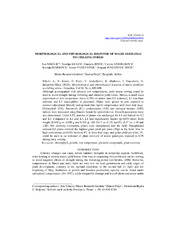Приказ основних података о документу
Morphological and physiological response of maize seedlings to chilling stress
| dc.creator | Nikolić, Ana | |
| dc.creator | Kravić, Natalija | |
| dc.creator | Ristić, Danijela | |
| dc.creator | Anđelković, Violeta | |
| dc.creator | Marković, Ksenija | |
| dc.creator | Vančetović, Jelena | |
| dc.creator | Ignjatović-Micić, Dragana | |
| dc.date.accessioned | 2020-09-24T13:24:34Z | |
| dc.date.available | 2020-09-24T13:24:34Z | |
| dc.date.issued | 2020 | |
| dc.identifier.issn | 0534-0012 | |
| dc.identifier.uri | http://rik.mrizp.rs/handle/123456789/814 | |
| dc.description.abstract | Although accompanied with adverse low temperatures, early maize sowing could be used to avoid drought during flowering and diminish yield losses. Herein, a small-scale experiment of low temperature stress (LTS) on maize lines L1 (tolerant), L2 (medium tolerant) and L3 (susceptible) is presented. Plants were grown in pots exposed to exterior suboptimal (March) and optimal (late April) temperatures until three leaf stage. Chlorophyll (CH), flavonoids (FL), anthocyanins (AN) and nitrogen balance (NBI) indices were measured using Dualex Scientific optical device. Growth parameters were also determined. Under LTS, number of plants was unchanged for L1 and halved for L2 and L3. Compared to L2 and L3, L1 had significantly higher (p<0.05) shoot fresh weight (0.649 g vs. 0.406 g and 0.303 g), AN (0.17 vs. 0.13) and FL (1.47 vs. 1.38 and 1.36). For recovery evaluation, plants were transplanted into the field. Transplanted stressed L1 plants showed the highest grain yield per plant (55g) in the field. Due to high correlations (p<0.01) between FL in three leaf stage and grain yield per plant, FL could be used as an indicator of plant recovery of maize genotypes exposed to LTS during early sowing. | en |
| dc.description.abstract | Ranom setvom kukuruza se može izbeći efekat suše u fazi cvetanja i tako preduprediti smanjenje prinosa uprkos nepovoljnim temperaturama u tom periodu. U ovom istraživanju prezentovani su rezultati efekta niskih temperatura na tri linije kukuruza: L1 (tolerantna), L2 (srednje osetljiva) i L3 (osetljiva). Biljke su gajene do faze trećeg lista u saksijama izloženim suboptimalnim (mart) i optimalnim (april) spoljnim temperaturama. Sadržaj hlorofila, flavonoida i antocijana kao i nitrogen balance index (NBI) su mereni korišćenjem uređaja Dualex Scientific (Force-A, Orsay, France). Takođe, mereni su i parametri rasta. U poređenju sa L2 i L3, L1 je imao značajno veću (p<0.05) svežu masu nadzemnog dela biljke (0.649 g vs. 0.406 g i 0.303 g), antocijana (0.17 vs. 0.13) i flavonoida (1.47 vs. 1.38 i 1.36). Biljke su presađene u polje radi procene oporavka. Presađene biljke genotipa L1 su pokazale najveći prinos po biljci u polju (55g). S obzirom na visoku korelaciju između sadržaja flavonoida u fazi trećeg lista i prinosa po biljci (p<0.01), flavonoidi mogu biti korišćeni kao indikator oporavka biljke kukuruza izloženih niskim temperaturama u fazi rane setve | sr |
| dc.language.iso | sr | sr |
| dc.language.iso | en | sr |
| dc.publisher | Beograd : Društavo genetičara Srbije | sr |
| dc.relation | info:eu-repo/grantAgreement/MESTD/Technological Development (TD or TR)/31028/RS// | sr |
| dc.rights | openAccess | sr |
| dc.rights.uri | https://creativecommons.org/licenses/by-nc-nd/4.0/ | |
| dc.source | Genetika | sr |
| dc.subject | chlorophyll | sr |
| dc.subject | growth | sr |
| dc.subject | low temperature | sr |
| dc.subject | phenolic compounds | sr |
| dc.subject | plant recovery | sr |
| dc.title | Morphological and physiological response of maize seedlings to chilling stress | en |
| dc.type | article | sr |
| dc.rights.license | BY-NC-ND | sr |
| dc.citation.volume | 52 | |
| dc.citation.issue | 2 | |
| dc.citation.spage | 689 | |
| dc.citation.epage | 698 | |
| dc.identifier.wos | 000577916600021 | |
| dc.identifier.doi | 10.2298/GENSR2002689N | |
| dc.identifier.fulltext | http://rik.mrizp.rs/bitstream/id/4257/2020-Genetika_0534-00122002689N.pdf | |
| dc.type.version | publishedVersion | sr |


